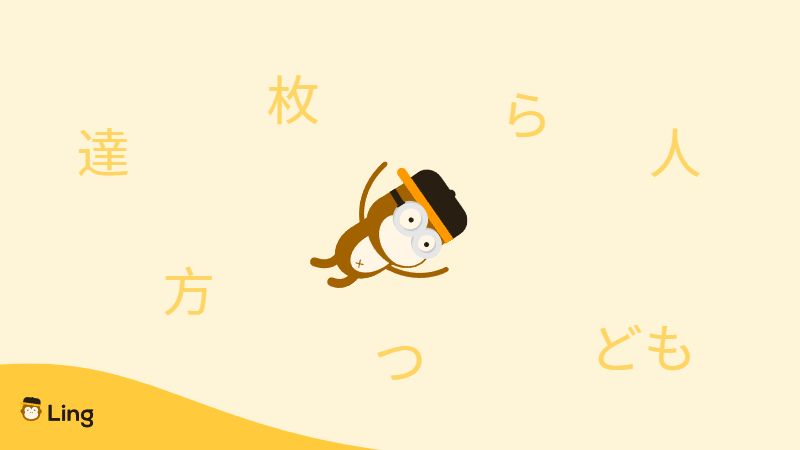Are you one of those Japanese learners who are curious about making Japanese words plural? Then read this article carefully because we’ll be covering how to make Japanese nouns plural as well as learning the plural form of some nouns.
Additionally, we’ll also touch upon the fundamental differences between plural nouns in English and Japanese. If you’re ready to learn Japanese, let’s get started!
Page Contents:
- Are There Any Plurals In The Japanese Language?
- English Plurals VS Japanese Plurals
- What Are The Plural Suffixes In Japanese
- Making Japanese Words Plural With Counters
- Other Words To Express Plurality
- Start Learning Japanese With Ling!
Are There Any Plurals In The Japanese Language?
You may be thinking what a silly question that is, but it’s actually more complex than you think. In spoken language, Japanese people don’t differentiate the plural and singular words. So, the border between them is little, if any. This may not make any sense to someone who doesn’t have a good command of the Japanese language. But don’t worry, I’ll make sure that you leave this blog post saying, “Aha, now I get it!”
English Plurals VS Japanese Plurals
Using the plural in Japanese grammar isn’t as simple as attaching -s or -es to the end of nouns. That form of pluralization doesn’t actually exist. That’s why Japanese loanwords sound weird when we try to pluralize them in English like we don’t say animes or mangas.
In English, you basically add -s, -es, or -ies at the end of a singular noun to turn it into a plural noun. In another case, some nouns have irregular plural forms, such as mouse – mice. However, in Japanese, we do that with the help of counters and suffixes.

What Are The Plural Suffixes In Japanese
One way to make Japanese nouns plural is by adding a plural suffix at the end of the word. Here are the Japanese suffixes you should know to make a noun plural.
~達 (Tachi)
This suffix is the most common way to refer to an object or a person in plural form. All you have to do is to just add 達 (tachi) at the end of a noun.
You might have seen this one while learning personal pronouns in Japanese. You actually use this suffix when you want to say “we” which is an explicitly plural word.
- 私達 (watashitachi) – We, us
However, don’t try to apply the same thing when saying “you” in the plural form in Japanese. Because the word 貴方達 (anatatachi) sounds so informal that it is considered rude.
~ら (Ra)
Again, be careful when using the suffix ら (ra), as it can be considered impolite in some cases. However, it’s also used to express humility. For instance, when you say 僕ら to refer to your own group, you’re being humble, not rude.
You may want to learn the certain situations in which ら (ra) is considered polite and impolite to avoid feeling awkward in a conversation.
~方 (Gata) And ども (Domo)
These suffixes indicate respect for the persons mentioned.
Usually, people feel the need to express politeness or formality when mentioning a group of superior or senior people. In that case, you can add 方 (gata) or ども (domo) at the end.
Making Japanese Words Plural With Counters
In Japanese, the best indicators of the plurality of a noun are Japanese counters. But counters vary based on the noun they modify.
By the way, we have a whole other blog post explaining counters and numbers in Japanese, so if you’re feeling lost, I suggest you have a look at that one!
As there are a lot of different counters in the Japanese language, we’ll cover only the most commonly used ones in this blog post.
人 (Nin)
This counter describes the number of people in Japanese. Here are a few examples that include the counter 人.
- 一人 – One person
- 二人 – Two persons
- 三人 – Three persons
- 子供が三人います。(kodomo ga sannin imasu) – I have three children.
枚 (Mai)
This counter describes the number of flat objects like paper, sheets, etc. in Japanese. Here are a few examples that include the counter 枚.
- 一枚 (Ichimai) – One flat object
- 二枚 (Nimai) – Two flat objects
- 三枚 (Sanmai) – Three flat objects
- クレジットカードが二枚財布に入っています。(Kurejittokādo ga ni-mai saifu ni haitte imasu.) – I have two credit cards in my wallet.
Ling offers easy-to-understand Japanese lessons that you can learn at your own pace. Just grab your iOS or Android device right now and head to the Google Play Store or Apple App Store to download it.
~つ (Tsu)
This counter describes the number of other objects in Japanese. Here are a few examples that include the counter つ.
- 一つ (Hitotsu) – One thing
- 二つ (Futatsu) – Two things
- 三つ (Mittsu) – Three things
- リンゴを二つ持っています。(Ringo o futatsu motte imasu.) – I have two apples.
Other Words To Express Plurality
Here are other words that are used for pluralizing nouns with no suffixes.
| English | Japanese | Romaji | Sound |
|---|---|---|---|
| Some, several | いくつか | Ikutsuka | |
| A lot, lots of | たくさん | Takusan | |
| Many | 多く | Ooku | |
| All | 全て | Sugute | |
| Total | 全部 | Zenbu | |
| Few | 少し | Sukunai | |
| People | 人々 | Hitobito | |
| Houses | 家々 | Ieie | |
| Trees | 木々 | Kigi |
Start Learning Japanese With Ling!
If you want to learn Japanese from scratch, Ling is here for you!
From bite-sized lessons to puzzles and an exclusive chatbot, you can practice real-life conversations and gain a better understanding of the Japanese language.
Thousands of learners use the Ling app to improve their language skills, so why not join them? Download Ling, and get ready to speak Japanese soon! Plus, don’t forget to visit our Japanese blog weekly to learn more about the Japanese language and culture!
Until next time, じゃあまたね!
































































